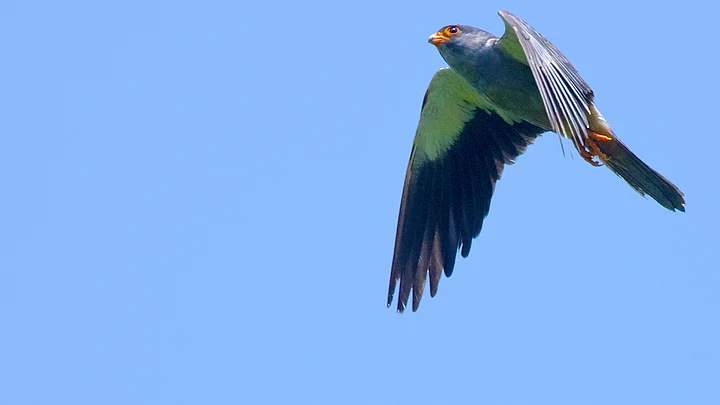It took off from the dense tree cover like the raptor it is, craned its neck taking all in with a piercing gaze while the invisible direction finder in its tiny head gave it the desired bearing. And then with a lazy flap or two of its sleek wings, off it vanished into the blue yonder.
Originating from Nagaland, the flight will take it all the way to east Africa over the Arabian Sea, a distance covering more than 4,000 kms from the west Indian coastline. But that is just half the story. Meet the Falco amurensis, Amur falcon to you and me.
Amur falcons are slowly becoming the face of conservation in India, but not before paying a very heavy price for years. An untold number of these birds would be killed every year as bush meat, particularly in Nagaland, before a bunch of do-gooders decided to turn the tide.
Saving the Amur Falcon
- Conservation efforts in full
swing around the Doyang reservoir, associated with mass hunting of Amur falcon
- Falcons after being killed
were being sold for around Rs 25 each; the collective effort regarding
conservation started taking effect in 2012
- Conservationists relying on
radio tagging technique to keep an eye on dwindling numbers
- Conservation efforts finally
bearing fruits as the site is thronged with birding tour operators and bird
watchers’ groups to observe the annual falcon congregation
Conservation Pays Off
The effort is bearing fruit and the falcons, which are considered wonders for the longest overwater flight they undertake each year, are now almost safe in India. But that has taken some doing from conservationists, NGOs, different communities, the state and central governments and even the church. The hunters have now almost all turned protectors.
Weighing around 200 gms each, the Amur falcons are small birds of prey. They breed in the region between southern Siberia, Mongolia and northern China and winter in east and southern Africa. Their migratory flight path from Central Asia to the African continent takes them over India with the Doyang reservoir in Wokha district of Nagaland being their favourite roosting site where they start flocking in October and are almost all gone to Africa by November end.
Mass Hunting
The mass hunting of Amur falcons around the Doyang reservoir is linked to the economy and livelihood of the region. Hunters, mostly fishermen, used to drape the trees along the reservoir with fishnets and trap anything between 12,000 to 15,000 falcons a day. With a large number of hunter groups operating, the annual kill count shot well over the six-figure mark.
Brought to market places, the falcons were then plucked, smoked and sold for around Rs 25 each. That was the practice till a few years ago, but the collective effort to spread the message of conservation started taking effect in 2012.
“The ownership in the community for falcon conservation has significantly gone up and is a self-contained initiative by now with more and more participation of the locals. Most encouragingly, there is a trickle effect of the Amur falcon protection and conservation on overall birdlife. As envisioned, the Amur falcon could become the torch bearer for overall conservation in days to come,” says Ramki Sreenivasan, a Bangalore-based wildlife photographer dedicated to the cause of conserving the falcons at ground zero since the past few years.
Radio-Tagged Falcons
There is tangible evidence that the Amur falcons are now almost safe in this country. To record their behavioural and ecological pattern and their flight path, ornithologists had radio-tagged three falcons from the Doyang roost site on November 6, 2013, fitted them with a solar-powered electronic device for tracking avian species and released them the following day on November 7.
The birds, one male was named Naga and two females named Wokha and Pangti after the state of Nagaland, the district where they roost and the village that contributed hugely towards the falcons’ conservation, respectively.
Naga and Pangti returned to the Doyang roosting site in Nagaland in 2014 after completing their return journey to Mongolia/northern China from southern Africa, but the whereabouts of Wokha remains unknown. Conservationists presume she has either died or lost the radio chip.
“Shoring everybody’s hopes about Amur falcon conservation, Naga and Pangti returned to the Doyang roosting site this season too. It is a huge pat on the back for all those who worked for the falcons’ protection, particularly the people of Nagaland,” Sreenivasan said.
Tourist Attraction
The Amur falcons are now turning into an alternative source of economy in areas that were once their killing fields. “Tourism, centring round the spectacular Amur falcon congregation, is slowly emerging as a meaningful source of livelihood and the former hunters are now stakeholders. The development would also contribute towards natural conservation, as is desired,” the wildlife activist pointed out.
Substantiating the claim, inquiries about tourism prospects at the Doyang site are pouring in. “Inquiries about homestay and camping at the Amur falcon congregation site are coming from the UK, Australia and The Netherlands,” confirmed Asit Biswas of Help Tourism, a major tour operator.
According to him, birding tour operators and bird watchers’ groups from abroad and around the country are expressing interest to visit the site to observe the stunning annual falcon congregation and contribute towards the conservation success story as well.
(The writer is a Siliguri-based journalist)
